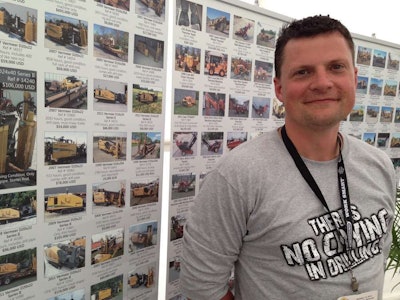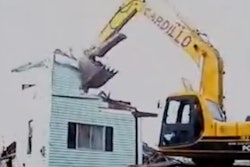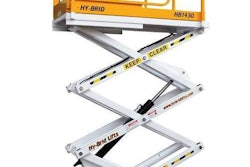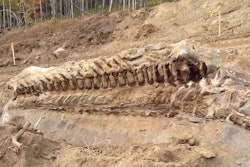 At ICUEE 2013, Bob Martin, HDD Broker’s general manager, stands in front of a listing of used drills available from his company.
At ICUEE 2013, Bob Martin, HDD Broker’s general manager, stands in front of a listing of used drills available from his company.While the ICUEE show in Louisville was an opportunity to see the horizontal directional drills fresh from the factory, it also offered attendees the chance to kick the tracks on used drills … or consider selling their older drills to make way for new.
We talked to two exhibitors, MTI Equipment and HDD Broker, to get a feel for what’s happening in the used drill market. Although MTI Equipment was acquired by The Charles Machine Works last year, and Vermeer owns HDD Broker, both companies emphasized they are brand-agnostic when it comes to selling used drills: all makes and models are welcome.
“We serve the customer who’s concerned about the higher prices of buying new and the fear of buying used,” says Kevin Smith, MTI’s general manager.
The two companies approach the market in different ways. MTI acquires all of its for-sale inventory, bringing it into its location in Englewood, Florida, where it’s inspected and serviced. “Then we’ll actually drill with the machine three to five times, continuing to look for issues, and repairing them before sale,” Smith says. “That way, we can show buyers different machines, have them actually operate a few and help them make an educated decision.”
Can’t make it to Florida? All machines are listed on www.mtiequip.com.
HDD Broker, as the name implies, is a brokerage firm that advertises and sells rigs for private owners, banks, and equipment dealers worldwide, marketing through its website, www.hddbroker.com. Inspections are handled through qualified third parties. “We’re not selling a product, we’re selling a service. It’s not our machine,” says Bob Martin, HDD Broker’s general manager. “We’re the jungle guide to help you purchase this equipment. We know what to look out for and the path that needs to be taken.”
“The used HDD marketplace is naturally growing along with the overall machine population, as horizontal drilling has become more widely accepted around the world,” Martin says. While the United States remains HDD Broker’s largest market—with 60 percent of the units it sells staying here—Canada, Russia, Colombia, Venezuela and Brazil have been good export markets. “And we expect Australia to explode because of their huge broadband project,” he says.
“We’re appealing to more than just start-up companies,” Smith says. “We’re also seeing companies use our machines for secondary units for short term work. When a contractor is buying used, they need to be selective.” Key wear areas for drills include the rack and pinion, vise assemblies, frames and the drill pipe thread. “A large percentage of the machines that come in will have issues and typically need repairs on the mud pump,” Smith adds, “and you don’t find that unless you hook it up and drill with it. If a contractor is not familiar with these units, they need to make sure they have someone inspect it who is,” Smith says.
Market trends
According to Martin, 24,000 to 60,000-pound pullback machines are popular, reflecting their versatility in installing fiber, water and gas. “Pipeline and energy have been strong for the past few years, so the 100,000-pound-plus machines continue to sell well.”
 Kevin Smith, MTI’s general manager, in front of the company’s booth at ICUEE 2013.
Kevin Smith, MTI’s general manager, in front of the company’s booth at ICUEE 2013.“We’ve also seen a shift from the 24,000 to 30,000-pound class to more units in the 20,000-pound class,” Smith comments. “Fiber installations continue to drive a lot of activity.”
The used market, of course, is tied to the new machine market. When customers switch to new models, their older models enter the used market. “As the prices come out for new machines, it establishes the price for used drills,” Smith says.
“And this is a tremendous year for that, since manufacturers have introduced a lot of new drills,” Martin comments.
Another factor: Tier 4 equipment. “Tier 4 is not only driving complexity into the units, it’s driving costs, and that has had a positive impact on the pre-owned market,” Smith says.
The profile of the used drill buyer is changing, Martin says. “There’s an on-going transfer of generations within companies, and the incoming generation is little bit different, taking more advantage of new technology and training.” Overseas, he sees customers who are young, more entrepreneurial, and willing to take a risk.
MTI, bought by The Charles Machine Works last year, started in 1986. HDD Broker has been in business for 13 years; Vermeer bought them in 2011.
Extras for drillers
HDD Broker recently rolled out a mobile listings app that enables customers to use their phone to fill out all the information and submit it directly to HDD Broker. The company’s new InfoCheck program encourages sellers to provide comprehensive information on the machines they’re selling. Each listing is evaluated on eight points, such as machine details and photos, inspection reports, work history, videos, etc. Customers can sort the listings by its InfoCheck rating. “It helps both the sellers and the buyers,” Martin says. HDD Broker also offers an extended warranty qualifying 5-year-old and younger equipment with less than 5,000 hours.
MTI has a users forum on it’s website, www.hddforums.com. “It’s an information sharing site,” Smith says, “ a place for people to talk about what and what is not working. One of the biggest challenges of the industry is sharing information to help each other grow and learn.”
“Looking ahead, we’re expecting to see a good international market — which is about half our business — as well as a continued strong domestic market, driven by energy,” Smith says.













